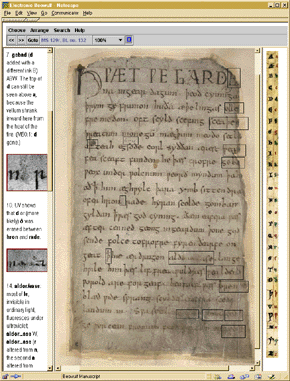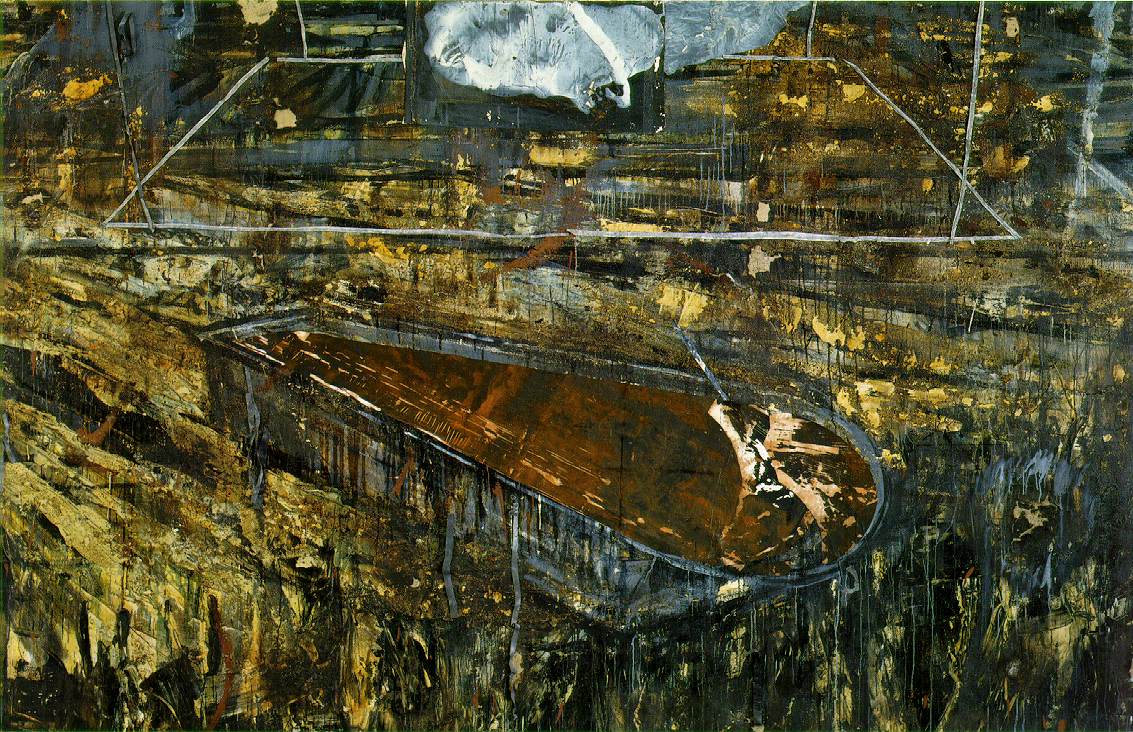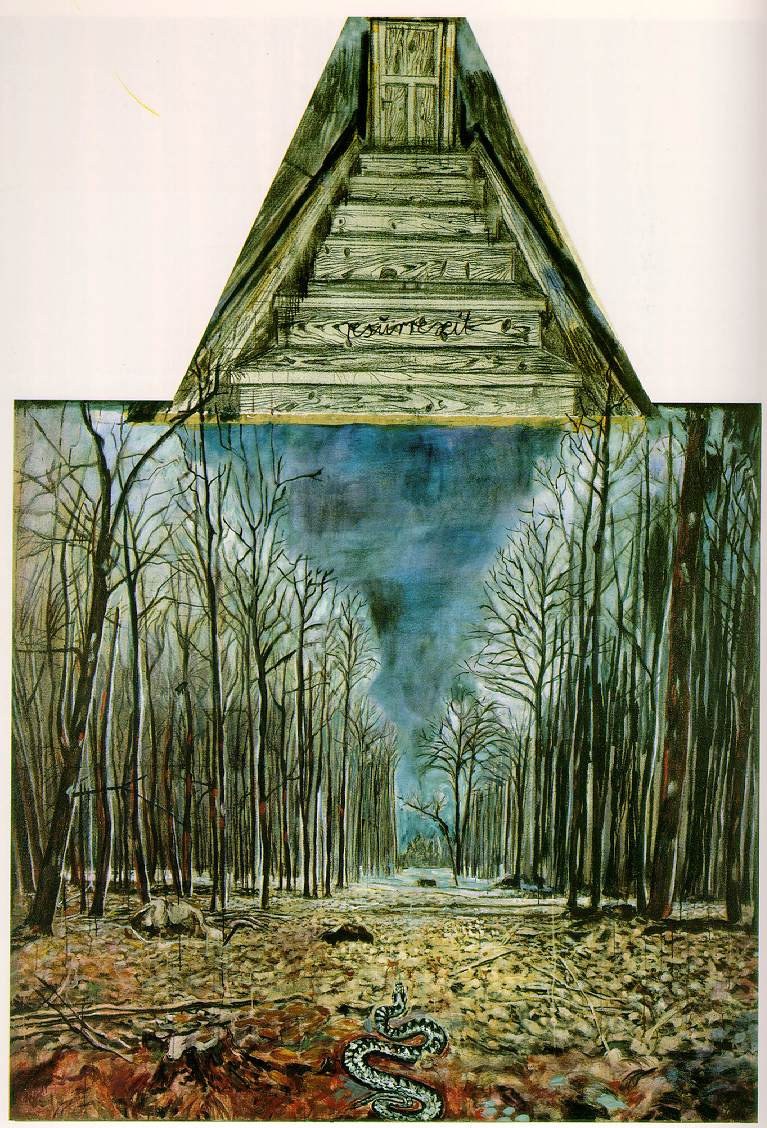
.gif)

.gif)
Kevin Kiernan et al., The Electronic Beowulf (2 CD-ROMs; Ann Arbor: University of Michigan Press, 2000)
Pinin Brambilla Barcilon and Pietro C. Marani, Leonardo: The Last Supper (Chicago: University of Chicago Press, 1999)
These are ruminations upon the curatorial intentions behind two recently-unveiled restoration projects -- Kevin Kiernan et al.'s Electronic Beowulf and Pinin Brambilla Barcilon's twenty-year restoration of da Vinci's Last Supper -- and also upon what might ultimately be at stake in the recuperation and reconstruction of the historical artifact (both in material and psychic space); further, I am trying to work out various ways of describing how, exactly, the scholar works in time with things that have fallen out of time, and whether or not there are ethics to be considered in the scholarship of art that "collects" memory, especially since, as Borges once reminded us, this art is always "passing, yet remaining, a mirror to the same inconstant Heraclitus, who is the same and yet another, like the river flowing" (Juan Luis Borges, "The Art of Poetry"). Finally, I think it is fruitful to consider The Electronic Beowulf as a project, not just of textual duplication and recuperation, but also as a work of art restoration, and then to "think" Kiernan's project alongside other contemporary art restoration projects in a variety of disciplinary contexts in order to connect The Electronic Beowulf to a larger stream of intellectual discourse about meaning in art, and about the relationship between art, history, and memory.

Anselm Kiefer, The Red Sea (1984-85)
I. History's Dark Woods
In her provocative essay, "Memory, History, Revelation: Writing the Dead Other," Edith Wyschogrod writes that "The past does not give itself all at once as spectacle . . . but is disclosed by the 'not' that is imprinted . . . sous rature in what is actually imaged and told. . . . To remember is to grasp occurrences in the manner of holding-in-front-of-oneself not only that which was but that which could have been" (in Memory and History in Christianity and Judaism, ed. Michael A. Signer [Notre Dame, IN: University of Notre Dame Press, 2001], 24). Furthermore, Wyschogrod writes that
Some historical narratives contain breaks in structure that I shall call their discursive space of authorization. Such spaces are often signaled by specific forumlae such as the announcement in Exodus, "I am that I am." The formula is a warning that there is a blank in the narrative that points to the governance of the events it recounts by that which is altogether outside the narrative. These blank spaces are the placeholders of revelation, a kind of white light that, unlike the formulae that announce them, illuminate the events recounted without ever becoming the focus of visibility. (ibid., 21)
The person wishing to render an accurate picture or account of the past must recognize that "the discursive space of memory is always already an ethical space," and the historian stands, as it were, "under [the] judgment" not only of the absent dead, but also of an "unincorporable infinite" that can only manifest itself in the blank spaces of the "predicative and iterative historical narrative" (ibid., 25, 31-32). Yet, as Wyschogrod also reminds us, if we believe that "history is judged in accordance with the claims of the dead Others," we should also remind ourselves of Nietzsche's caution in "The Uses and Abuses of History": "Who compels you to judge? If it is your wish--you must first prove that you are capable of justice. As judges you must stand higher that that which is to be judged; as it is you have only come later" (ibid., 31). But this is just a caution. Following Wyschogrod's line of thinking, the work of art rescued from the flow of history -- such as the Beowulf manuscript or da Vinci's Last Supper -- is both the carrier of a distinct cultural act and memory situated in a particular place and time which states, "it could not have been otherwise" -- it was thus, and not thus -- and also the placeholder of everything that is exterior to and in excess of that memory, what the Polish writer and artist Bruno Schulz called "the immensity of the transcendental" (Sanatorium Under the Sign of the Hourglass, trans. Celina Wieniewski [Boston, 1978], 14). In his book Sanatorium Under the Sign of the Hourglass, Schulz's narrator argues that there are some events that are too immense to be "contained in mere facts," and which the "ground of reality" cannot carry, and therefore,
they quickly withdraw, fearing to lose their integrity in the frailty of realization. . . . as a result, white spots appear in our biography -- scented stigmata, the faded silvery imprints of the bare feet of angels, scattered footmarks on our nights and days -- while the fullness of life waxes, incessantly supplements itself, and towers over us in wonder after wonder. . . . An event may be small and insignificant in its origin, and yet, when drawn close to one's eye, it may open in its center an infinite and radiant perspective because a higher order of being is trying to express itself in it and irradiates it violently. (ibid., 13-14)
The narrator of Schulz's book, in fact, is the young artist-genius and hero of his own mytho-autobiography who continually draws the world close to his own eyes and perceives in it the violent irradiations of this higher order of being; in something as simple as a spring dusk he perceives "labyrinths of depth, warehouses and silos of things, graves that are still warm, the litter, and the rot" (ibid., 47). But perhaps we should also remember here the words of the survivor of Auschwitz, Primo Levi, who worried constantly that it might not be enough for the artist to bear witness to that which others have not seen or experienced, and further, that there are certain realms into which the writer-witness, for all his good intentions, cannot travel:
We survivors are not only an exiguous but also an anomalous minority: we are those who by their prevarications or abilities or good luck did not touch bottom. Those who did so, those who saw the Gorgon, have not returned to tell about it or have returned mute, but they are the "Muslims," the submerged, the complete witnesses, the ones whose deposition would have a general significance. They are the rule; we are the exception. (The Drowned and the Saved, trans. Raymond Rosenthal [New York: Vintage Books, 1989], 83-84)
.jpg)
Henri Rousseau, La tour eiffel (1898)

Jeanne Moreau (Paris, 1928)
Standing in stark contrast to Schulz's depiction of the artist's notice of the eternal in the ordinary and Wyschogrod's provocative and obviously theological (and even, Hebraic) construction of the obligations of history to memory and even to that which stands outside of memory is the French historian Pierre Nora's viewpoint that memory and history are actually opposed to each other, and furthermore, "What looms on the horizon of every historical society . . . is presumably a final, definitive disenchantment. . . . the ambition of the historian, is not to exalt what actually happened but to annihilate it" ("Introduction: Between Memory and History," in Pierre Nora, ed., Realms of Memory: The Construction of the French Past, vol. 1, ed. Lawrence D. Kritzman, trans. Arthur Goldhammer [New York, 1996], 3). Modern historiography, especially, in Nora's view, has contributed to the split between memory and history because it sows doubt about its own methods and sources and takes past mentalities as its chief subject of critical dissection. Nevertheless, in the breach between memory and history lie the places that Nora terms "lieux de memoire," or memory sites. According to Lawrence Kritzman, Nora coined the term in order to denote the "'memory places' of French national identity as they have been constructed since the middle ages," and memory must here be understood, not in its literal sense, but in its "'sacred context' as the variety of forms through which cultural communities imagine themselves in diverse representational modes," with realms of memory functioning as "an inventory of loci memoriae" ("Foreword," Realms of Memory, 1: ix). More specifically, the "lieu is a templum; something singled out within the continuum of the profane (whether in time, space, or both), a circle within which everything counts, everything is symbolic, everything is significant. In this sense, the lieu de memoire has a dual nature: it is a hermetic excrescence upon the world, defined by its identity and summed up by its name, but at the same time open to an infinite variety of possible other meanings" (Nora, "Introduction," Realms of Memory, 1: 19-20). Such memory sites in French culture cover a broad variety of loci -- bodies as well as buildings, flags and anthems, landscapes and statues -- and they include the prehistoric caves at Lascaux, Joan of Arc, the Eiffel Tower, Versailles, the "Marseillaise," the films of Truffaut and Godard, Gitane cigarettes and the face of Jeanne Moreau, even the Tour de France (just to name a few), all of which "are the result of an imaginary process that codifies and represents the historical consciousness of 'quintessential France'" (Kritzman, "Foreword," 1: x). The historian's task, finally, according to Nora, is to immerse himself in the minute empirical detail of the lieux de memoire of his culture--to become the historian of lieux de memoire, as it were--and to unravel the bonds of sublime unreason and passion with which we have tied ourselves to these sites. The Beowulf manuscript and da Vinci's Last Supper are, of course, lieux de memoire par excellence.
I have briefly sketched some of Wyschogrod's and Nora's ideas about the relationship between memory and history in order to indicate the branching tracks of thought that have pulled me through the thicket of "thinking" Kiernan's Electronic Beowulf alongside Barcilon's restoration of The Last Supper as complementary projects of historical "memory-work," yet there is still another voice worthy of consideration, I think, in this theoretical conversation: how might the modern visual artist contribute to this conversation about the relationship between memory and history, and between history and its representation? Anselm Kiefer, a German artist born in the auspicious year of 1945, and who now lives in self-imposed exile in France, has spent much of his career grappling with this subject, and he has produced a large body of operatic, monumental canvasses that provide an extended and mournful meditation upon Germany's darker historical episodes, especially Nazism and the Holocaust. And he has done this in a style that, according to art critic Peter Schjeldahl, dissolves the "seemingly permanent contradictions between photo-based, intellectually dry Conceptualism and old time, emotionally sublime Abstract Expressionism" ("lost in the terrain: anselm kiefer," The Village Voice). The art critic Mark Stevens has called Kiefer a "strangely seductive figure who . . . refuses to simply sterilize or denature Nazi imagery. Instead, he boldly enters -- mucks about in -- the dirty space that lies between the great German Romantics and their horrifying Nazi offspring" ("Prussian Blues," New York Magazine, 4 Jan. 1999). In the 1970s and 1980s, Kiefer concentrated much of his artistic energy on paintings of the barren, rutted German landscape that included bits of straw and actual hunks of dirt, as if, in Stevens's words, "the great German romance with the land could no longer remain an illusion but must now be literally rubbed in the viewer's eyes" (ibid.). Many of these paintings make direct reference to various aspects of German culture and history. In fact, it was during this period that Kiefer also embarked upon his Sorrow of the Nibelung (1973) project in an abandoned schoolhouse where he wrote the names of Germany's myth-gods and heroes (Gunther, Hagen, Rudiger, Kriemhilde, etc.) under lit torches that eventually burnt the script into ashes. Some paintings undertaken during this period, such as Margarete, painted in 1981, even made use of Jewish culture. The title is taken from the Romanian Jewish poet Paul Celan's "Death Fugue," which is set in a death camp where Jewish prisoners are forced to dig their own graves to dance music.
.jpg)
Anselm Kiefer, Margarete (1981)
According to Gerhard Richter, "Kiefer's enigmatic work is, in the theoretical intensity and aesthetic obsession with which it confronts the historical, without common measure in much of contemporary at" ("History's Flights, Anselm Kiefer's Angels," Connecticut Review 24 [2002]: 114). Further, Richter writes that Kiefer's variegated work
returns us again and again to the difficulty of a series of questions. What is history? What will its relation to presentation have been? What are the links between strategies of aesthetic figuration and the politics of memory and counter-memory? What makes it possible, today, to continue to evoke history in a time of stasis, a moment that seems out of joint? Does the presentation of history necessarily imply a search for lost former presences, fugitive moments of temporality that were once simply themselves and transparently comprehensible? Or may historical presentation involve the recognition that these temporal moments were never simply "present" as an essence in the first place? What does it mean that the historical presents itself not as a former presence but rather in the space of intersecting traces that inscribe its genealogical shifts and movements, and that, by extension, the historical was already -- even at the time of its retroactively projected former presence, the fiction of its anteriority -- a network of traces and relays? (ibid., 113)

Anselm Kiefer, Everyone Stands Under His Own Dome of Heaven (1970)
Kiefer's work has disturbed and shocked many Germans who are not comfortable with the way in which Kiefer has romanticized, lampooned, and also cauterized the heroic images--mythological and historical -- of Germany's past. In his 1970 painting Everyone Stands Under His Own Dome of Heaven , Kiefer painted himself in mock-Nazi salute under a blue dome situated on a barren field, thereby self-reflexively citing a political myth and also opening up the ground of ambiguity as regards the relationship between the individual and collectivity, between the supposed heaven adumbrated by the salute and the ravaged landscape that surrounds it.

Anselm Kiefer, Resurrexit (1973)
Resurrexit, painted in 1973, depicts a seemingly abandoned forest road -- the trees are daubed with blood, the only living inhabitant is the primeval snake (bottom center), and juxtaposed above the forbidding woods, centered at the vanishing point of the road that could have very easily led to the site of a former death camp, there is a wooden staircase, on the steps of which is scrawled in graffiti the word "Resurrexit." Tellingly, above this at the top of the stairs, the door is shut tight. The painting is unreservedly bleak and points to the forces that move history to its unspeakable, unrepresentable excesses. According to Richter, "Kiefer's work is concerned with the Sisyphean task of working through history and its imbrications in the mythical: to attempt to come to terms with their ghostliness, but also to employ them as the vexed prime material out of which a thought may flow into artistic form" (ibid., 115). And I would argue that this statement, as well as Kiefer's body of work, has more to do with the artistry and content of Beowulf and The Last Supper than one might at first imagine; it has, as well, something to do with what the curators of these works have wished to wrest out of them through the technologies of restoration.
from Eileen A. Joy, Postcard from the Volcano: Beowulf, Memory, History (book-in-progress)